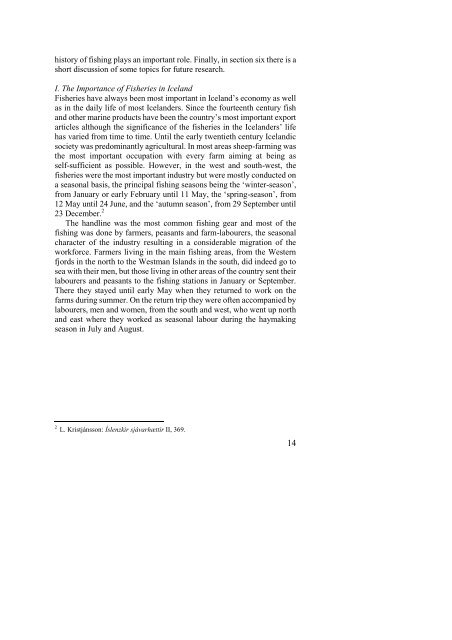The North Atlantic Fisheries, 1100-1976 - University of Hull
The North Atlantic Fisheries, 1100-1976 - University of Hull
The North Atlantic Fisheries, 1100-1976 - University of Hull
Create successful ePaper yourself
Turn your PDF publications into a flip-book with our unique Google optimized e-Paper software.
history <strong>of</strong> fishing plays an important role. Finally, in section six there is a<br />
short discussion <strong>of</strong> some topics for future research.<br />
I. <strong>The</strong> Importance <strong>of</strong> <strong>Fisheries</strong> in Iceland<br />
<strong>Fisheries</strong> have always been most important in Iceland’s economy as well<br />
as in the daily life <strong>of</strong> most Icelanders. Since the fourteenth century fish<br />
and other marine products have been the country’s most important export<br />
articles although the significance <strong>of</strong> the fisheries in the Icelanders’ life<br />
has varied from time to time. Until the early twentieth century Icelandic<br />
society was predominantly agricultural. In most areas sheep-farming was<br />
the most important occupation with every farm aiming at being as<br />
self-sufficient as possible. However, in the west and south-west, the<br />
fisheries were the most important industry but were mostly conducted on<br />
a seasonal basis, the principal fishing seasons being the ‘winter-season’,<br />
from January or early February until 11 May, the ‘spring-season’, from<br />
12 May until 24 June, and the ‘autumn season’, from 29 September until<br />
23 December. 2<br />
<strong>The</strong> handline was the most common fishing gear and most <strong>of</strong> the<br />
fishing was done by farmers, peasants and farm-labourers, the seasonal<br />
character <strong>of</strong> the industry resulting in a considerable migration <strong>of</strong> the<br />
workforce. Farmers living in the main fishing areas, from the Western<br />
fjords in the north to the Westman Islands in the south, did indeed go to<br />
sea with their men, but those living in other areas <strong>of</strong> the country sent their<br />
labourers and peasants to the fishing stations in January or September.<br />
<strong>The</strong>re they stayed until early May when they returned to work on the<br />
farms during summer. On the return trip they were <strong>of</strong>ten accompanied by<br />
labourers, men and women, from the south and west, who went up north<br />
and east where they worked as seasonal labour during the haymaking<br />
season in July and August.<br />
2 L. Kristjánsson: Íslenzkir sjávarhættir II, 369.<br />
14















